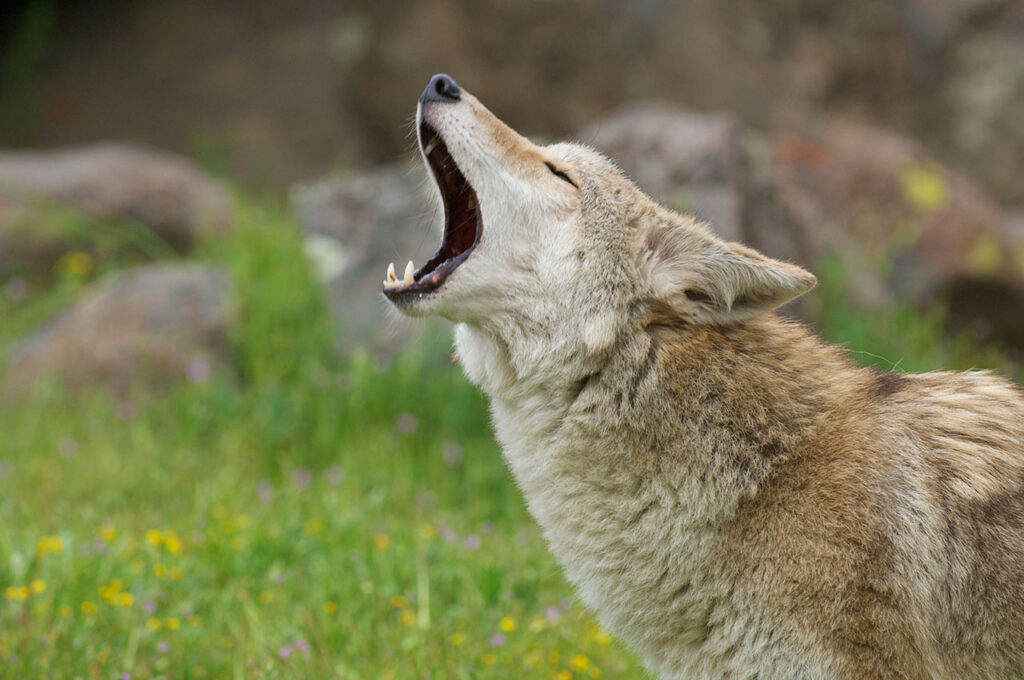Coyote Facts
Coyotes can be found throughout North and Central America. Mating occurs between January and March. A female coyote can give birth to up to 19 pups. Coyotes will eat mainly small mammals like rabbits, squirrels, and mice. Birds and insects are occasionally parts of their diet. They are nocturnal, usually hunting only after dark and in the early morning hours. Coyotes can carry diseases like distemper, hepatitis, parvovirus, rabies, mange, and tularemia.

Coyote Damage
Their constant yipping will become annoying to some people, and sometimes they’re just plain frightening to see. It’s possible for these animals to kill house cats and small dogs, as they will be seen as a source of food. Livestock, like chicken and sheep, are also at risk. When they’re not attacking pets or pastures, coyotes tend to help themselves to fruits and vegetables in your garden to balance out their diet. On occasion, they have attacked people if they feel threatened. Ordinarily, however, coyotes are more afraid of us than we are of them.
Coyote Disease
Transmission of disease is the biggest risk coyotes pose. Coyotes can transmit a disease to dogs called distemper. This disease can affect a dog’s respiratory, gastrointestinal, and nervous system. If you notice your dog sneezing, coughing, or being generally tired, see your vet immediately, as distemper can be fatal if left untreated. Coyotes can also transmit a disease called parvovirus to humans. Parvovirus is a disease that affects the lymphatic system and gastrointestinal tract. Additionally, coyotes carry a disease known as mange. Mange is a condition that causes deterioration of their coats. Another disease coyotes may transmit to people is tularemia, which affects the liver, causing loss of appetite and energy loss. Symptoms of tularemia include fever, tiredness, loss of appetite, red lesions, and possibly death. Lastly is rabies, a virus that can damage the nervous system and cause severe flu-like symptoms. Both humans and animals are susceptible to rabies. If you develop any unusual symptoms after coming into contact with a coyote, seek immediate medical attention.
Types of Coyote
Coyote Identification
The coyote commonly measures between four and five feet long, including their tails. Their bodies are covered in grayish brown to yellowish gray fur with a black strip along their backs. Their undersides are white, as well as their feet. Tails have a black tip, and legs are reddish brown.
Coyotes in the Yard & Garden
As adaptable animals, coyotes can live in many different environments. They love forests, grasslands, deserts, and swampy areas. They have grown accustomed to being around humans, so it is not uncommon for them to be seen in rural, urban, and suburban areas. They will run with their tails down, distinguishing them from wolves and dogs, both of which run with their tails straight out. Coyotes will yip, yelp, howl, growl, and bark. The tracks coyotes leave behind are more elongated than those of dogs, and more uniform in shape. Their droppings are twisted and will contain hair or berries. You’ll find coyote droppings on rocks, logs, or trails. Coyote body odor is not as strong as that of a dog. The bodies of prey will often be eaten clean, leaving bare bones and a carcass.
Frequently Asked Questions
How do I keep coyotes away?
Remove any artificial food sources like garbage cans or dumpsters. Seal them with a tight lid or straps so coyotes can’t get inside. Feed pets during the day and clean up any stray food that will attract the coyotes in the first place. Keeping bird feeders and areas around them clean, as coyotes will not only eat seed, but they will also eat animals that feed on those seeds like birds, mice, and squirrels. Always make sure you can see your pets, as they may be attacked by coyotes if left unattended. The same goes for young children. If coyotes are in your yard, it helps to scare them away. Scream, shout and wave your hands to ward them off. Spray them with a hose, if necessary. Keeping your yard fenced in will keep them off your property, but make sure they are strong and deep.
The safest way to take care of a coyote problem is to consult a licensed pest control expert who can remove them and protect the property.
What are the benefits of professional beaver or wildlife pest control?
Expert pest specialists have the educational background, equipment, and skill to control and remove wildlife nuisances from a property in a safe, efficient way.
If you’re struggling with coyotes on your property, contact us. Our technicians can remove the critters and help you regain control of your property and sanity.


